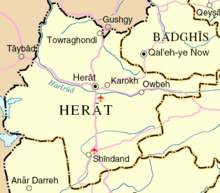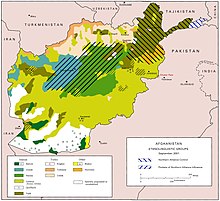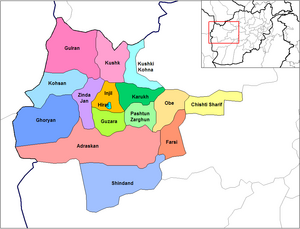This is an old revision of this page, as edited by NorthernPashtun (talk | contribs) at 06:21, 3 November 2011 (IP vandalism reverted). The present address (URL) is a permanent link to this revision, which may differ significantly from the current revision.
Revision as of 06:21, 3 November 2011 by NorthernPashtun (talk | contribs) (IP vandalism reverted)(diff) ← Previous revision | Latest revision (diff) | Newer revision → (diff) This article is about a province of Afghanistan. For its capital city, see Herat.Herat (Persian: هرات) is one the 34 provinces of Afghanistan; together with Badghis, Farah, and Ghor provinces, it makes up the north-western region of the country. Its primary city and administrative capital is also named Herat.
The region of Herat was historically part of the Persian Khorasan province and was controlled by the Tahirids followed by the Saffarids, Samanids, Ghaznavids, Ghurids, Ilkhanates, Timurids, and Saffavids until the early-18th century when it became part of the Afghan Hotaki dynasty followed by the Durrani Empire.
Overview


The province was one of the first major battlegrounds in the Soviet invasion of Afghanistan, and remained an active area of guerrilla warfare throughout, with local military commander and mujahideen Ismail Khan leading resistance to Soviet rule from 1979 until the Soviet withdrawal in 1989 (see the article on the city of Herat for further details). When the Soviets withdrew, Ismail Khan became the governor of the province, a position he retained until the Taliban took control of the province in 1995. Following the ousting of the Taliban in 2001 by the US and coalition forces as well as the Afghan Northern Alliance, Khan once again became governor of Herat. (See U.S. invasion of Afghanistan).
The province was ruled more or less autocratically by Khan, despite some attempts by the interim central government (headed by Hamid Karzai) to weaken the power of local strongmen. Khan's rule has engendered some controversy, though Herat has remained largely free of the violence that has plagued some other regions of post-Taliban Afghanistan.


In March 2003, the Endowment and Islamic Affairs Department of the provincial government began steps to restrict what it saw as un-Islamic vices, on March 1, 2003 banning the sale and public screening of movies and the performance of music in public, and on March 5, 2003 banning the viewing of movies entirely, as well as the possession and sale of satellite dishes.
Radio Free Afghanistan (an extension of the United States' Radio Free Europe program) reported negatively on these steps, noting that the restrictions were very similar to those that had been in place under the Taliban, and portraying them as a step backwards for the province. Khan reacted angrily to these reports, as well as some citing human rights violations in the province, branding the Radio Free Afghanistan reporters (who were Afghans) "traitors". On March 19, 2003, Ahmad Behzad, one of Radio Free Afghanistan's reporters for the story, was allegedly beaten and detained on Khan's orders. On March 21 Khan issued a threatening statement, saying "those Afghans from our city, through BBC and Radio Azadi, harm the dignity of our people... I would like to tell them that just like those who served the Russians and benefited from them, they too will meet the same end."

A war of words followed, with local journalists protesting angrily at what they read as a threat to use violence against dissenting journalists. President Karzai issued several statements largely siding with the journalists and expressing concern at the situation. This culminated in Khan ordering Behzad to leave the province permanently, despite his being a native of the city of Herat. Journalists responded with a cessation of news reporting in protest, beginning on March 24 (joined by the US's Radio Free Afghanistan, the UK's BBC service, Iran's Dari service, and a number of publishers of local newspapers and weekly news magazines). On March 28, Behzad met with President Karzai, who again expressed his support for the journalists and concern that the situation was affecting reconstruction in Herat and damaging the transitional government.
Khan backed down, claiming to have always supported journalistic freedom, and chalking the entire incident up to a misunderstanding. He released a statement saying, "the recent event that occurred was the result of a misunderstanding, and I hope it will not happen again. We are not against any Afghan or foreign journalist, and the reporters can be assured of their safety in our town, and can report on life in this country any way they wish." Behzad returned to Herat on April 3, 2003, and the local media resumed publishing.
The current governor of the province is Daud Shah Saba, and before him was Ahmad Yusuf Nuristani followed by Sayed Hussein Anwari, Gul Agha Sherzai, Sayed Muhammad Khairkhwa and Ismail Khan, who served before and after the Taliban.
Demographics
Further information: Demographics of Afghanistan

The population of the province is estimated at 1,762,157 people. According to Afghanistan's Ministry of Rural Rehabilitation and Development:
Around three quarters (77%) of the population of Hirat lives in rural districts while just under a quarter (23%) lives in urban areas. Around 50% of the population is male and 50% is female Dari and Pashtu are spoken by 98% of the population and 97.7% of the villages. Languages spoken by the remaining poopulation are Turkmeni and Uzbeki. Hirat province also has a population of Kuchis or nomads whose numbers vary in different seasons. In winter 98,506 individuals, or 4.1% of the overall Kuchi population, stay in Hirat living in 166 communities. Around Three quarters (75%) of these are short-range partially migratory, 12% are long-range partially migratory and 13% are settled. Half of migratory communities of both categories migrate within the winter area, as well as in the summer area. The most important summer areas for the short range migratory Kuchi are Kushki Sangi, Farsi, Adreskan, Kushk Kohna, Kushk Robad, Pashtun Zarghun, Shindand, Guzara, Chisht Sharif, Obeh, Kohistan and Karukh districts of Herat province (in decreasing order of importance). The long-range migratory Kuchi are predominantly fully migratory. Their summer areas are in Ghor province. The Kuchi population in the summer is 112311 individuals.
According to the Naval Postgraduate School, the ethnic groups of Herat Province is as follows: Tajiks, Pashtuns, Aimak, Hazaras, and others.
Population by districts
There are 16 districts within the province. These are listed in the table below.

| District | Capital | Population (2006) | Area |
|---|---|---|---|
| Adraskan | 56,193 | ||
| Chishti Sharif | 25,428 | ||
| Farsi | 28,252 | ||
| Ghoryan | 90,201 | ||
| Gulran | 106,983 | ||
| Guzara | 135,187 | ||
| Herat (Capital) | 397,456 | ||
| Injil | 224,607 | ||
| Karukh | 58,594 | ||
| Kohsan | 57,782 | ||
| Kushk | 133,446 | ||
| Kushki Kuhna | 41,642 | ||
| Obe | 75,175 | ||
| Pashtun Zarghun | 90,817 | ||
| Shindand | 185,418 | ||
| Zinda Jan | 54,976 |
Sport
Further information: Sport in AfghanistanFootball (soccer) is the popular sport in Herat Province, and in recent years cricket is also growing in popularity. The Province is represented in domestic competitions by the Herat Province cricket team. Afghanistan's national sport Buzkashi and a number of other sports are also played in the region.
Future

In April 2011 it was announced that the Italian Minister of Economic Development, Paolo Romani, had pledged $85 million towards an upgrade of Herat Airport, along with additional funds to develop a 28 kilometre road within the province. It was hoped that this, along with the standardisation of the airport to allow international flights, would encourage additional foreign investment in the region.
See also
- Herat (city)
- Azizabad airstrike
References
- "Afghanistan: emirate of Herat"
- ^ "B. Demography and Population" (PDF). United Nations Assistance Mission in Afghanistan and Afghanistan Statistical Yearbook 2006, Central Statistics Office. Afghanistan's Ministry of Rural Rehabilitation and Development. Retrieved 2011-01-12.
- "Province: Herat" (PDF). Program for Culture & Conflict Studies. Naval Postgraduate School. Retrieved 2011-07-05.
- http://www.nps.edu/Programs/CCS/Docs/PDF%20Maps/NewTribal/Herat.pdf
- Afghanistan Geographic & Thematic Layers
External links
- Tribal Map of Herat on nps.edu
- Radio Free Afghanistan (Radio Azadi) report on the incidents
- HeratNet latest news from Herat
| Places adjacent to Herat Province | ||||||||||||||||
|---|---|---|---|---|---|---|---|---|---|---|---|---|---|---|---|---|
| ||||||||||||||||
| Provinces of Afghanistan | ||
|---|---|---|
| Herat Province | ||
|---|---|---|
| Capital: Herat | ||
| Districts |  | |
| Populated places | ||
| Landmarks | ||